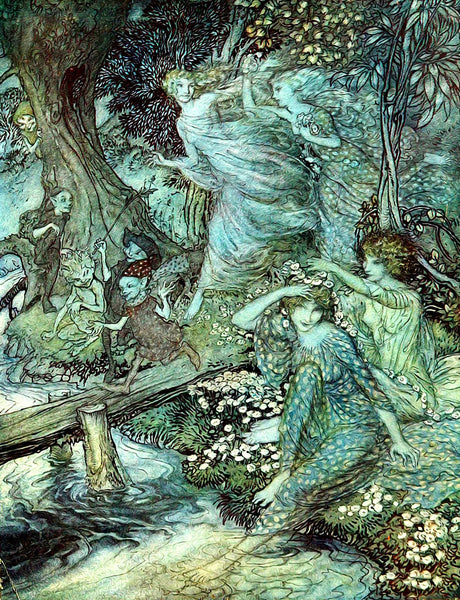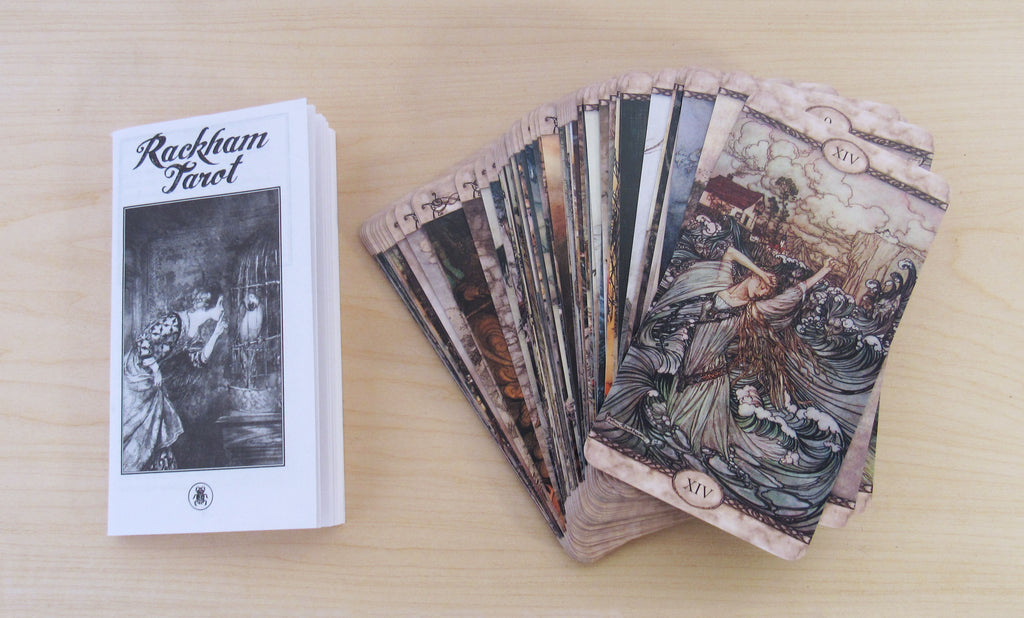Deck review: Rackham Tarot
Posted by Michelle Gruben on
 One of the most anticipated new Tarot decks of 2019, the Rackham Tarot is based on the artwork of the beloved illustrator Arthur Rackham. Rackham’s fantasy worlds are populated with elves and goblins, golden-haired princesses and sly old crones. His artwork appeals to occultists because of his skill in evoking the enchantment (and danger) of the Faery realms.
One of the most anticipated new Tarot decks of 2019, the Rackham Tarot is based on the artwork of the beloved illustrator Arthur Rackham. Rackham’s fantasy worlds are populated with elves and goblins, golden-haired princesses and sly old crones. His artwork appeals to occultists because of his skill in evoking the enchantment (and danger) of the Faery realms.
Arthur Rackham (1867-1939) was a major figure in the Golden Age of illustration, which lasted roughly from the 1890s to the start of the first World War. At this time, the major publishing houses in Britain would commission illustrators to embellish classic tales for children. These pictures and stories were collected in vellum-bound deluxe volumes (and cheaper trade editions). They were often given as Christmas gifts. The popularity of these storybooks declined by the 1920s, due to the shortages caused by WWI and a waning interest in fairies and fantasy as the world came to terms with industrialization.

During his long career, Rackham produced illustrations for Wagner’s Ring cycle, Peter Pan, Rip Van Winkle, Fairy Tales of the Brothers Grimm, and many other stories of magic and adventure. An expert draftsman, he also possessed a wild, expressive style of ink drawing that stands out against the more mannerly creations of other late Victorian storybook artists. The densely inked compositions are highlighted with tints of sepia, navy, celadon green, and ochre. On the whole, Rackham’s work has a foreboding, twilit aura that continues to inspire illustrators, fashion designers, and film directors who portray the world of Faery.

The Rackham Tarot consists of 78 cards in a tuck-top box. The two extras are a title card (with art from the box cover) and an ad for Lo Scarabeo’s Tarosophy association. The suits are Cups, Pentacles, Wands, and Swords. Only icons and numerals appear on the cards (no words). The Major Arcana have the standard titles and numbering (Strength is 8, Justice is 11). The cards are borderless with a parchment-colored header and footer for each card’s number and/or symbol.
Now for the bad news: The stock is quite thin. This is an annoying trend with many new decks from Lo Scarabeo. The only advantage is that it makes shuffling easier. (Here at the shop, we hear a lot of complaints about new decks being printed in China, but I swear most of those are better quality than the recent Italian-made Tarot decks.)

Anyway, moving on. The little white book is the standard Lo Scarabeo booklet in four languages. The card meanings, while fairly standard, lean toward the preachy and glib. I don’t think the booklet adds anything to the experience of using the Rackham Tarot.
Nevertheless, this deck has one major upside: The art. It’s Arthur Rackham, so of course it’s amazing. Every image is a world unto itself. Pale, ageless knights guide their steeds through twisted trees. Water nymphs linger in luminous pools. His artistic vision is a potent cocktail of innocence, eroticism, and menace. (Rackham clearly knew his Fae.) The reproduction of the art is overall very good—crisp, detailed, and true to color. It’s not stretched or over-cropped. The fairy gowns and wings are on point.

Some of the illustrations found in this deck will be very familiar, having been endlessly reproduced on posters and greeting cards. Others are easy to recognize as figures from myths and fairy tales—Pandora and Diana the Huntress and the Little Mermaid. Seeing these cards inspires wonder for Rackham’s gifts as an illustrator, and a desire to re-visit and re-tell these timeless tales.
But the vast majority of the scenes will leave you scratching your head unless you happen to be an art historian. Not knowing the stories they correspond with means, in my opinion, a missed opportunity to find divinatory meanings in these cards. It would be nice to have the artwork titles/captions revealed in the little white book, but no dice. To understand the stories behind each image would require a lot of time-consuming research—or at least a big Rackham coffee table book close at hand for cross-referencing.

As a reading deck, the Rackham Tarot suffers from sameness. The emotional range of Rackham’s collected drawings isn’t enormous to begin with, but when shrunk to Tarot size they’re dark and eerie almost without exception. There’s no brightness in the Sun card, little joy in the 10 of Cups. This is a common issue when the work of a single artist gets shoehorned onto the Tarot. The Rackham Tarot does a better job than most, but some of the match-ups still feel strained.
The Rackham Tarot is so beautiful that I wish I could recommend this deck more highly. It has sold briskly since we added it to the store last month. (We received it ahead of its planned release date of June 2019.) I've found myself hoping that these decks are being shipped to collectors or experienced readers rather than Tarot newbies.
It’s an art deck—meaning that it’s not well-suited for beginning readers. I have a lot of practice reading different Tarot decks, and to be honest, I found this deck daunting to interpret right out of the box. (As mentioned earlier, the book is no help at all.) The cards may work better as portals for Faery journeying or meditation than as a tool for traditional cartomancy.
The Rackham Tarot occupies a strange place in the Tarot market. It’s too fragile and moody to be a workhorse reading deck, nor does it really give Rackham’s illustrations the deluxe treatment they deserve. Last year’s Rackham project, the Fairy Oracle, also suffered from subpar printing and less-than-thoughtful card meanings. But don’t lose hope: More illustrations from the Golden Age of storybooks pass into the public domain every day. It may be that the definitive fairy tale deck is still to come.
Rackham’s artwork is enjoying a resurgence in popularity, rising with the tide of all things Victorian, Gothic, and Fae. If you’re a fan, you certainly won’t want to pass up this deck.
However, if you’re on the hunt for a fairy-themed deck that’s more balanced and accessible, I recommend the Tarot of the Hidden Realm over this one. If Rackham’s fairy worlds are too dark and dangerous for your taste, Mystic Faerie Tarot (featuring the art of Linda Ravenscroft) is a lighter take on the Fae that’s also an excellent reading deck.
What do you think of the Rackham Tarot? Let other readers know in the comments!
Read more in the archive.
Share this post
- Tags: 2019, deck reviews, divination, faery, tarot
